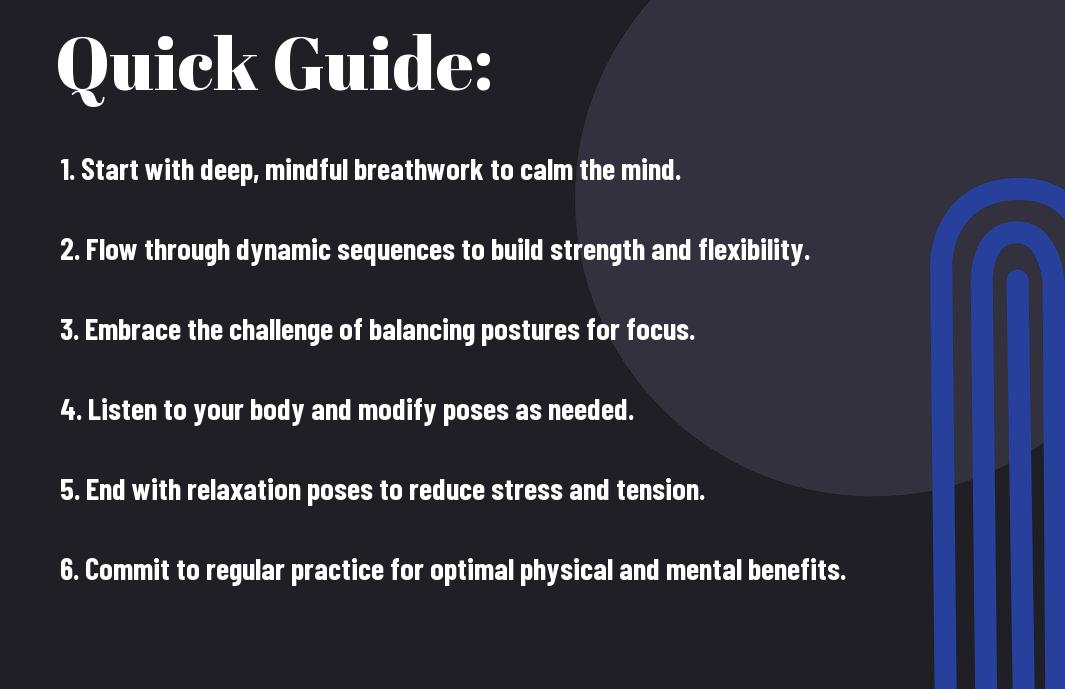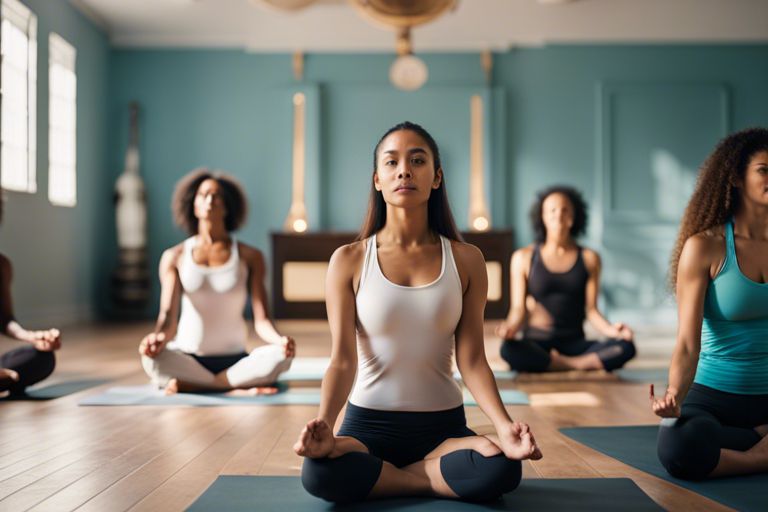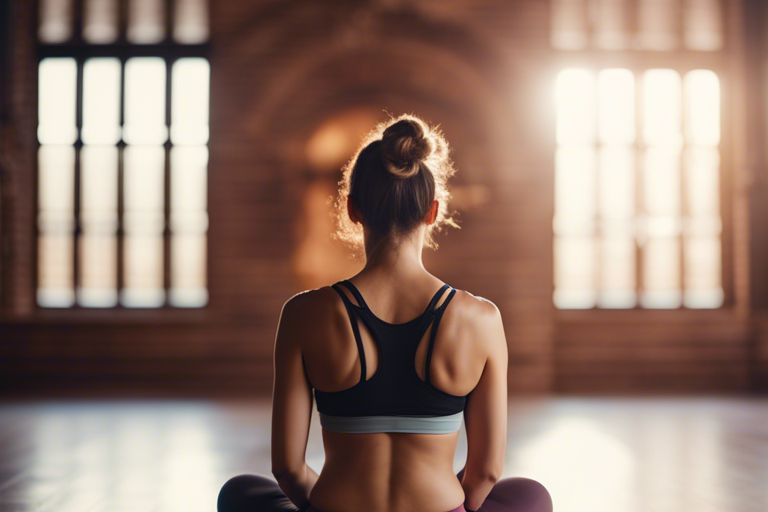Well-being is paramount, and Vinyasa yoga offers a pathway to physical and mental harmony. This guide researchs into the benefits of incorporating Vinyasa yoga into your routine, from improving flexibility and strength to enhancing focus and stress-relief. Discover step-by-step instructions on how to perform Vinyasa poses correctly and unlock a world of well-being through this dynamic and energizing practice.
Key Takeaways:
- Enhanced Flexibility: Vinyasa yoga involves flowing sequences of poses that help improve flexibility by targeting different muscle groups in the body. Consistent practice can lead to increased range of motion and mobility.
- Stress Relief: The focus on linking breath with movement in vinyasa yoga can help calm the mind and reduce stress levels. It promotes mindfulness, leaving practitioners feeling relaxed and rejuvenated.
- Strength Building: Vinyasa yoga builds strength by engaging various muscles during dynamic movements. It can help tone muscles, improve balance, and enhance overall body strength through regular practice.

Understanding Vinyasa Yoga
Definition and Origins
A dynamic form of yoga, Vinyasa is a practice that focuses on coordinating movement with breath to flow from one pose to the next. This synchronization helps to create a continuous and meditative flow of movement. Vinyasa yoga originates from the more traditional Hatha yoga and is known for its energizing and fast-paced nature.
Types of Vinyasa Yoga
Vinyasa Flow: Vinyasa Flow is a popular form of Vinyasa yoga that involves a seamless transition from one posture to another, often linked with sun salutations and focused on building strength and flexibility.
Power Yoga: Power Yoga is a more intense and athletic form of Vinyasa that focuses on building strength and stamina through a challenging sequence of poses. Ashtanga Yoga: Ashtanga Yoga follows a specific sequence of poses and is known for its physically demanding practice that helps to build internal heat and purify the body. Kundalini Yoga: Kundalini Yoga combines breathwork, movement, and meditation to awaken energy at the base of the spine and move it upward through the chakras.
| Vinyasa Flow | Seamless transition between poses |
| Power Yoga | Intense and athletic practice |
| Ashtanga Yoga | Specific sequence of poses |
| Kundalini Yoga | Focus on energy awakening |
For instance, Power Yoga can be a great choice for individuals looking to challenge themselves physically and build strength, while Kundalini Yoga may be more suitable for those seeking a spiritual and meditative practice. However, it is important to consult with a yoga instructor before plunging into any new practice, especially if you have any existing health conditions or concerns. Assume that you listen to your body and make modifications as needed to prevent injury.
Physical Benefits of Vinyasa Yoga
Improved Flexibility and Strength
To truly understand the physical benefits of Vinyasa yoga, one must first understand the importance of improved flexibility and strength. Any regular practitioner of Vinyasa yoga will experience a significant increase in flexibility, as the dynamic flow of poses helps to stretch and lengthen muscles and joints. Additionally, the continuous movement from one pose to another helps to build strength in various muscle groups throughout the body.
Weight Management and Balance
Weight management and balance are two key physical benefits that Vinyasa yoga offers. Through consistent practice, individuals can achieve and maintain a healthy weight by burning calories and increasing metabolism. Furthermore, the focus on balance in Vinyasa sequences helps to improve overall stability and coordination.
Physical balance not only refers to the ability to maintain a steady pose but also encompasses a sense of inner equilibrium. Vinyasa yoga helps individuals find balance in their bodies and minds, promoting overall well-being.
Enhanced Cardiovascular Health
Assuming a more active Vinyasa practice can lead to enhanced cardiovascular health. The dynamic nature of Vinyasa sequences gets the heart pumping and blood flowing, which can improve overall cardiovascular function. This form of yoga can help lower blood pressure, increase endurance, and promote a healthy heart.
Cardiovascular health is crucial for overall well-being, and incorporating Vinyasa yoga into a fitness routine can have significant positive impacts on heart health and overall quality of life.
Mental and Emotional Benefits of Vinyasa Yoga
All 11 Benefits of Yoga for Physical and Mental Health | Ro practitioners experience a wide range of mental and emotional benefits from their practice. Vinyasa yoga, in particular, is known for its ability to improve mental well-being and emotional balance.
Reduced Stress and Anxiety
Anxiety can be a debilitating condition that affects daily life. Vinyasa yoga helps reduce stress and anxiety by promoting relaxation through focused breathing and mindful movement. This type of yoga practice encourages practitioners to be present in the moment, which can help alleviate anxious thoughts and promote a sense of calmness and control.
Improved Mood and Cognitive Function
Now, Vinyasa yoga has been shown to improve mood and cognitive function by increasing levels of serotonin and dopamine in the brain. These feel-good neurotransmitters help regulate mood and promote feelings of happiness and well-being. Additionally, the practice of Vinyasa yoga involves mindfulness and concentration, which can enhance cognitive function, memory, and overall mental clarity.
Understanding the mental and emotional benefits of Vinyasa yoga can provide a powerful motivation to incorporate this practice into your daily routine. Whether you are looking to reduce stress, improve mood, or increase cognitive function, Vinyasa yoga offers a holistic approach to mental well-being.
Increased Self-Awareness and Confidence
Function Vinyasa yoga emphasizes self-awareness and introspection, allowing practitioners to connect with their inner selves on a deeper level. This increased self-awareness can lead to greater self-confidence and a more positive self-image. By tuning into their thoughts, emotions, and physical sensations during practice, individuals can develop a stronger sense of self and cultivate a greater sense of self-assurance.

Tips for Starting a Vinyasa Yoga Practice
To begin a Vinyasa yoga practice, it is crucial to approach it with intention and a willingness to learn and grow. Here are some tips to help you get started on your Vinyasa yoga journey:
Finding the Right Class or Instructor
If you are new to Vinyasa yoga, it may be helpful to try out a few different classes or instructors to see what style resonates with you. Look for classes labeled as beginner-friendly or gentle Vinyasa flow to ease yourself into the practice. It is crucial to find an instructor who you connect with and who can guide you effectively through the practice. After all, finding the right class or instructor can greatly enhance your Vinyasa yoga experience.
Creating a Home Practice Space
Assuming you might not always be able to make it to a yoga studio, creating a home practice space can be beneficial for maintaining a consistent practice. Designate a quiet and clutter-free area in your home where you can roll out your mat and focus on your practice. Consider adding elements like candles, crucial oils, or calming music to enhance your experience. Practice in a space that makes you feel comfortable and inspired to practice regularly.
Setting Realistic Goals and Expectations
Starting a Vinyasa yoga practice requires setting realistic goals and managing your expectations. Remember that progress takes time, and it is okay to start slow and build your practice gradually. Space out your practice sessions throughout the week and be patient with yourself as you work on improving your strength, flexibility, and overall well-being through Vinyasa yoga.
Step-by-Step Guide to a Vinyasa Yoga Practice
Preparing for Your First Class
Now, before stepping into your first Vinyasa yoga class, there are a few things you can do to prepare yourself. Make sure to wear comfortable clothing that allows you to move freely and bring a water bottle to stay hydrated throughout the practice. Arrive a few minutes early to set up your mat and introduce yourself to the instructor. Let them know if you have any injuries or medical conditions they should be aware of.
| Benefits | Tips |
| Improves flexibility and strength | Listen to your body and modify poses as needed |
| Encourages mindfulness and focus | Focus on your breath to stay present during the practice |
Basic Postures and Breathing Techniques
Any Vinyasa yoga practice includes a series of basic postures and breathing techniques that form the foundation of the flow. Common postures include downward facing dog, plank, warrior poses, and cobra. These poses help to build strength, increase flexibility, and improve balance. The breath is also a key component of Vinyasa yoga, with each movement coordinated with either an inhale or an exhale.
It is important to focus on your breath throughout the practice to help calm the mind and connect with your body. The breath should be smooth and steady, flowing in and out through the nose. By linking movement with breath, you can create a moving meditation that helps to quiet the mind and deepen your practice.
Flowing Through a Vinyasa Sequence
Yoga classes typically follow a sequence of poses that flow together in a dynamic and fluid way. A typical Vinyasa sequence may include sun salutations, standing poses, balancing poses, inversions, backbends, and a cool down. The transitions between poses are smooth and continuous, creating a moving meditation that synchronizes breath with movement.
Guide yourself through the sequence with awareness and intention, moving mindfully from one pose to the next. Be mindful of your alignment and listen to your body, modifying poses as needed to suit your own practice. With regular practice, you will find greater strength, flexibility, and mental clarity both on and off the mat.
Factors to Consider When Practicing Vinyasa Yoga
Despite the numerous benefits of Vinyasa Yoga, it’s important to practice it mindfully and consider certain factors to maximize its advantages and prevent injuries.
Safety Precautions and Modifications
Now, when practicing Vinyasa Yoga, it is crucial to listen to your body and modify poses as needed. If you have any existing injuries or health conditions, inform your instructor before the class so they can provide alternative poses for you. Proper alignment is crucial in avoiding strain on your muscles and joints. Always warm up before transitioning into more intense poses to prevent injury and strain.
Nutrition and Hydration for Optimal Performance
Safety in Vinyasa Yoga also includes maintaining proper nutrition and hydration for optimal performance. This practice involves a lot of movement and sweat, so it’s important to stay hydrated throughout your session. Ensure you have enough energy by consuming a light, easily digestible meal a few hours before your practice.
This will help fuel your body without weighing you down during your yoga session.
Scheduling and Consistency
Performance in Vinyasa Yoga can be enhanced with consistent practice and a well-thought-out schedule. Regular practice can help improve your flexibility, strength, and mental focus. Another important aspect to consider is to find a routine that works for you and stick to it. This consistency will not only enhance your physical abilities but also deepen your mental clarity and emotional well-being.
Weighing the Pros and Cons of Vinyasa Yoga
Now let’s take a closer look at the pros and cons of practicing Vinyasa yoga to help you make an informed decision about incorporating it into your wellness routine. Below, you will find a breakdown of the benefits and potential drawbacks of this dynamic yoga style in the tables:
| Advantages | Disadvantages |
|---|---|
| Improves flexibility and strength | High risk of injury if not practiced mindfully |
| Enhances mental focus and concentration | May be challenging for beginners |
| Increases cardiovascular health | Not suitable for individuals with certain injuries or medical conditions |
| Encourages mindfulness and stress reduction | Requires consistent practice to see significant progress |
Advantages for Physical and Mental Health
Consistently practicing Vinyasa yoga can lead to a range of benefits for both your physical and mental well-being. By following the sequences of poses and focusing on the breath, you can improve your flexibility, build strength, and cultivate a sense of inner peace. For more information on getting started with Vinyasa yoga, check out Vinyasa Yoga Basics.
Potential Drawbacks and Challenges
Some individuals may find Vinyasa yoga challenging due to its fast-paced nature and the need to synchronize movement with breath. It’s important to listen to your body and make modifications as needed to prevent injury and ensure a safe practice. Another key consideration is that Vinyasa yoga may not be suitable for those dealing with certain health conditions or injuries that could be exacerbated by the vigorous nature of this style. It is always recommended to consult with a healthcare provider before starting any new exercise regimen, including Vinyasa yoga.
Summing up
Following this step-by-step guide on Vinyasa Yoga can unlock a myriad of benefits for both your physical and mental well-being. By focusing on the breath, movement, and mindfulness, Vinyasa Yoga helps to improve flexibility, strength, and balance while also reducing stress and increasing mental clarity.
With regular practice, you can experience increased energy levels, enhanced focus, and an overall sense of well-being. Whether you’re a beginner or an experienced yogi, incorporating Vinyasa Yoga into your routine can lead to a healthier and happier lifestyle. So, roll out your mat, take a deep breath, and begin your journey towards physical and mental wellness!
FAQ
Q: What is Vinyasa Yoga?
A: Vinyasa Yoga is a style of yoga that focuses on connecting breath with movement. It involves a series of poses that flow seamlessly from one to the next, creating a dynamic and energizing practice.
Q: What are the benefits of practicing Vinyasa Yoga?
A: Practicing Vinyasa Yoga can have numerous physical and mental benefits. It can help improve flexibility, strength, and balance, as well as promote relaxation and stress relief. It also helps increase mindfulness and focus through the continuous flow of movement and breath.
Q: How can I unlock the benefits of Vinyasa Yoga?
A: To unlock the benefits of Vinyasa Yoga, it is important to practice regularly and with mindfulness. Focus on linking your breath with your movements, maintaining proper alignment in each pose, and listening to your body’s needs. Consistency and patience are key to experiencing the full range of benefits that Vinyasa Yoga has to offer.











